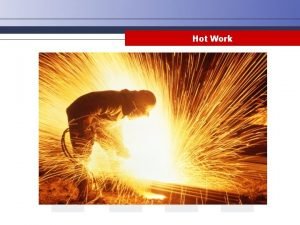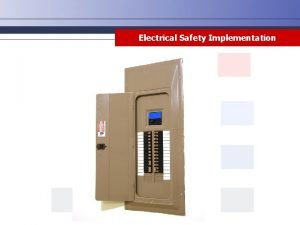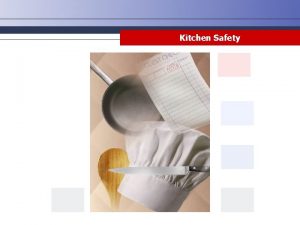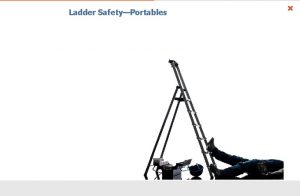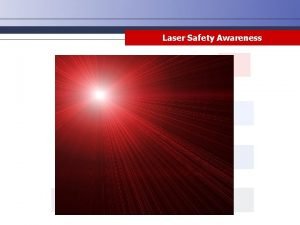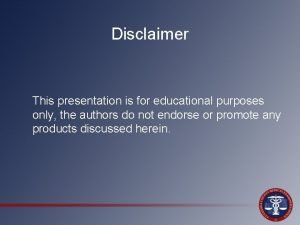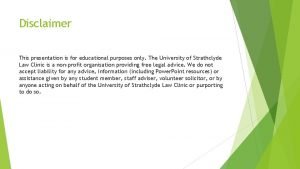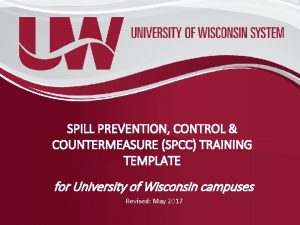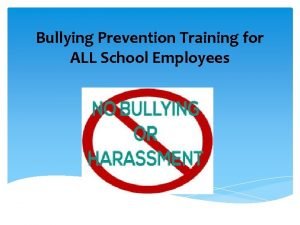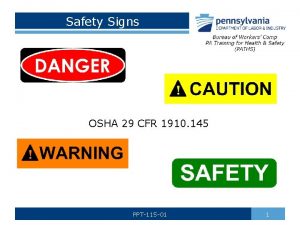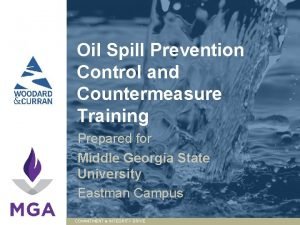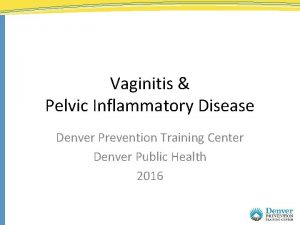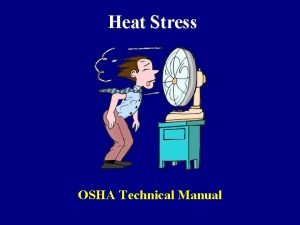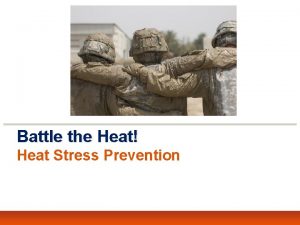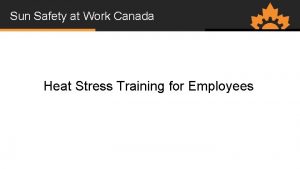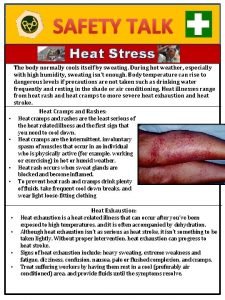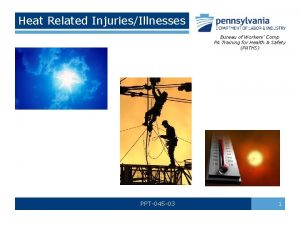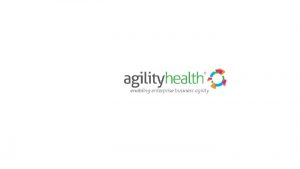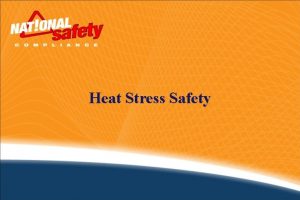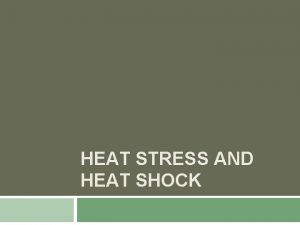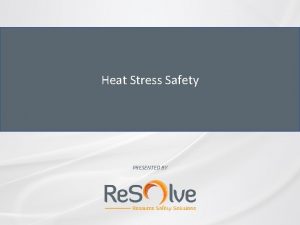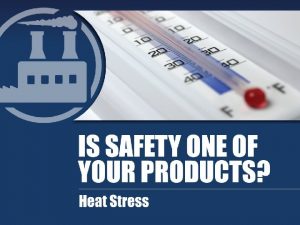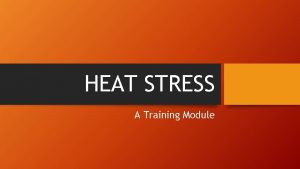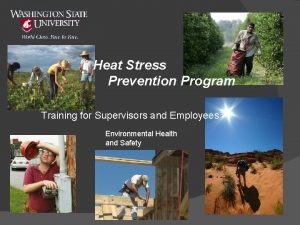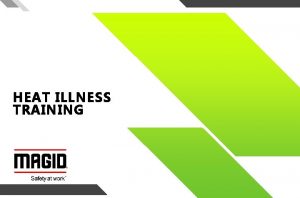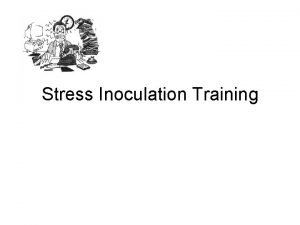Heat Stress Prevention Disclaimer This training material presents





































- Slides: 37

Heat Stress Prevention

Disclaimer • This training material presents very important, pertinent information. It should not be assumed, however, that this program satisfies every legal requirement of every state. Some states require the training be developed and delivered by an individual with specific training and experience. • This training is AWARENESS LEVEL and does not authorize any person to perform work or validate their level of competency; it must be supplemented with operation and process-specific assessments and training, as well as management oversight, to assure that all training is understood and followed. • Your organization must do an evaluation of all exposures and applicable codes and regulations. In addition, establish proper controls, training, and protective measures to effectively control exposures and assure compliance. • This program is neither a determination that the conditions and practices of your organization are safe, nor a warranty that reliance upon this program will prevent accidents and losses or satisfy local, state, or federal regulations.

Learning Objectives • What causes and contributes to heat stress • How to recognize heat illnesses • How to treat and prevent heat illnesses • The requirements for a heat stress prevention program

Course Outline 1. Introduction 2. Risk Factors 3. Heat Stress Prevention Program 4. Heat Illnesses 5. Engineering Controls 6. Work Practice Controls 7. Administrative Controls 8. Temperature Guidelines 9. Summary

Introduction When employees are required to work in hot environments for extended periods of time, every precaution must be taken to minimize the chances of heat-related illnesses, which may result in death if left untreated. This course provides information about measures employers can take to avoid heat-related illnesses.

Introduction Body temperature: • Normal body temperature is 98. 6°F. • Temperature regulation is called “thermoregulation” or “homeostasis. ” • The body gains or loses heat in the following ways: ‒ Radiation ‒ Convection ‒ Conduction ‒ Evaporation When the body’s natural defense mechanisms against heat fail, heat stress will occur.

Introduction Heat index: • It is a single value that reflects how hot the air feels. • Humidity prevents sweat evaporation and makes the air feel hotter. • Direct sunlight can increase heat index values. • The heat index is a better measure than air temperature alone. • Depending on the heat index value, the risk for heat-related illness can range from low to extreme.

Introduction

Environmental Factors • The temperature of the air • Humidity • Radiant heat exchange with surrounding surfaces: ‒ The sun ‒ Bright lights ‒ Boiler ‒ Furnace • Air movement: ‒ A lack of breeze ‒ A lack of ventilation

Behavioral Factors • The clothing and personal protective equipment or PPE worn • Exertion • Physical contact with warm or hot objects • Inadequate fluid intake

Personal Factors • A poor level of physical fitness • Obesity • Chronic or acute illnesses • Certain conditions • Medications • Alcohol or drugs • Lack of acclimatization • Age

The Written Program Create, implement, and maintain an effective plan for minimizing and treating heat illness. • Make the plan available to all employees on site as well as to company representatives and local authorities upon request. • Provide copies of the plan in both English and any other languages understood by the majority of employees. SAFETY ASSURANCE TIP The Heat Stress Prevention Plan must address all requirements covered in this course, including potable water provisions, shade, preventative cooldown rest periods, high heat procedures, acclimation, and training policies and procedures.

Employee Training must include the following: • Causes and contributing factors of heat stress • Role of PPE in causing and controlling heat stress • How to recognize heat stress • How to treat heat stress • Employee responsibilities regarding prevention and reporting • Caution during summer

Employee Training Employees must know their rights: 1. Freedom to exercise their rights to a heat stress-free workplace without retaliation 2. Access to first aid and emergency response procedures 3. The employer’s responsibility to provide water, shade, cool-down rests, and access to first aid 4. The employer’s use of acclimatization methods and principles

Emergency Reporting and Response • Assure that medical services are available and easily contacted. • Employees must know who to contact to report signs of heat stress, i. e. , a supervisor, other designated individual, or 911. • They need a means to contact help, and they must know how to provide directions. • Supervisors and employees must establish and maintain an effective means of communication through voice, visual gesture, or electronics. Electronic devices must have a reliable signal. • Assure that the work area is staffed with a person able to administer first aid. • Employees must know how to provide treatment until emergency personnel arrive. SAFETY ASSURANCE TIP Review your emergency preparedness plan and make sure supervisors and employees are designated to contact emergency services.

Results of Heat Stress • Injuries due to sweaty palms, fogged up glasses, confusion, and dizziness • Illnesses: ‒ Heat exhaustion ‒ Heat cramps ‒ Heat stroke

Monitor for Heat Cramps • Heat cramps are muscle pains or spasms that occur because of a salt imbalance. • They usually occur in heavily-used muscle groups. • If heat cramps occur, the employee must: – Stop all activity and rest in a cool place. – Drink clear juice or a sports beverage. – Seek medical attention if cramps do not subside in an hour. – Rest for several hours after cramps subside.

Know the Symptoms of Heat Exhaustion • Heat exhaustion is a form of heat-related illness that can develop after several days of exposure to high temperatures. • It is caused by dehydration. • It may lead to heat stroke. • Symptoms include the following: ‒ Extreme weakness or fatigue ‒ Nausea or vomiting ‒ Headache ‒ Irritability ‒ Clammy, moist skin with profuse sweating ‒ Rapid, weak heartbeat ‒ Slightly elevated body temperature ‒ Dizziness, lightheadedness, or fainting ‒ Heat cramps

Treating Heat Exhaustion If you detect signs of heat exhaustion, notify a supervisor or appropriate individual with first aid training. The individual giving care must: • Move the victim to the shade or to an airconditioned environment. • Cool the person by fanning, sponging with cool water, or applying ice packs. • If conscious, give the victim cool, nonalcoholic beverages.

Heat Stroke • Heat stroke is immediately lifethreatening. • Heat stroke occurs when all of the body’s cooling mechanisms have been exhausted. • Symptoms include the following: ‒ Body temperature of 104°F or higher ‒ Red, hot, dry skin, with lack of perspiration ‒ Nausea ‒ Dizziness ‒ Confusion or irrational behavior ‒ Strong and rapid pulse ‒ Seizures or convulsions ‒ Loss of consciousness or coma

Heat Stroke Treatment: • Notify a supervisor and follow the emergency action procedure. • Move the victim to the shade or an airconditioned environment. • Cool by fanning, sponging, and applying ice packs. • Give water only if conscious. • Remove boots, socks, and other excess clothing.

Shaded Areas In temperatures exceeding 80°F: • Provide shaded areas large enough to accommodate all employees during meal, rest, or recovery periods. This can be achieved through rotation of employee breaks. • Locate shaded areas as close as feasible to the areas where employees are working. • The provision of seating is recommended.

Controlling Radiant Heat • Installing reflective screens or shields • Insulating hot indoor surfaces

Engineering Controls Ventilation types: • Air conditioning removes the heat from the air. • If the air temperature is less than 95°F, fans can help employees stay cooler. – Fans increase convection and evaporation. – They provide movement, which must directly impact the employee.

Establish a Water Station • Locate water stations as close as possible to areas where employees are working. • Assure that the water is pure, fresh, cool, and free for employees. SAFETY ASSURANCE TIP Establish a pre-shift inspection policy to assure that shade and water are being provided as close as possible to the areas where employees are working.

Fluid Choice • In elevated temperatures, increase fluid intake. • Benefits include the following: ‒ Replacement of expelled water ‒ Temperature regulation ‒ Joint lubrication ‒ Spine protection ‒ Waste processing • Water is preferable. • Fluids with high electrolyte concentration are acceptable in small quantities. • Avoid alcohol, caffeine, carbonation, and sugar.

Fluid Intake Employees must: • Drink water before, during, and after working in heat, even if they do not feel thirsty. • Drink small amounts frequently: ‒ 6 ounces/15 minutes ‒ 4 cups of water/hour if there is excessive sweating • Not: ‒ Drink extremely cold fluids. ‒ Drink extreme amounts.

Proper Diet affects the ability to regulate heat. • Hot foods add directly to body heat. • Heavy meals reduce the ability to get rid of heat. • Employees should: ‒ Eat light, cool meals. ‒ Not skip meals.

Clothing Choices • Clothing should be: ‒ Reflective. ‒ Light-colored. ‒ Lightweight. ‒ Loose-fitting and breathable. • Clothing should cover the exposed parts of the body. • In direct sun, a hat with a wide brim or bill may be helpful. • Consider providing: ‒ Ice vests. ‒ Water-cooled garments. ‒ Phase change liquid cooling vests. ‒ Cooling cloths made from special fabrics. Firefighters use reflective clothing.

Acclimatization • Acclimatization is the physical process of adapting to a different thermal environment. • It occurs during one to two weeks of exposure, depending on: ‒ Temperature. ‒ Humidity. ‒ Health and conditioning. • Gradually increase and length of time of work. • Observe new employees during their first 14 days of employment in high heat areas. • Re-acclimatization is necessary if: ‒ Employees are away for a week or more. ‒ The temperate increases significantly.

Monitoring • Monitor for symptoms of heat illness. • It can be done by supervisors and other employees. • Watch those with risk factors more closely: ‒ Heavy protective clothing ‒ Working in direct sun • Consider monitoring employees’ heart rate and body temperature. • Shorten work cycles and increase rest periods if employees’: ‒ Body temperatures are over 98. 6°F. ‒ Heart rates are over 110 beats per minute. SAFETY ASSURANCE TIP Closely monitor work site temperature changes to assure that your heat stress controls are adequate.

Rest Breaks • Allow and encourage rest periods of at least 5 minutes for employees feeling that they need protection from overheating. • Encourage employees to stay in shaded areas during rest areas. • Never order employees back to work if they exhibit symptoms of a heat illness.

Scheduling • Reduce work loads. • Rotate strenuous tasks. • If the heat index is at or above 115°F, suspend: ‒ Strenuous work. ‒ Work requiring non-breathable clothing. • Reschedule strenuous jobs for the cooler part of the day.

Heat Waves Assign supervisors to closely observe and monitor employees during a heat wave. A heat wave is defined as: • Consistent temperatures over 80°F. • Anytime the temperature is 10° higher than the average high daily temperature in the preceding five days. SAFETY ASSURANCE TIP Review or create new plans to monitor employees in high heat conditions. Institute a ratio of one supervisor to 20 or fewer employees, a mandatory buddy system, or a consistent practice for supervisors to check on employees.

Extreme Heat When work site temperatures equal or exceed 95°F, the following procedures for extreme heat are necessary: • Establish and maintain communications between employees and supervisors. • Institute mandatory 10 -minute break periods after every two hours worked. • Supervise new employees for acclimatization. • Monitor all employees for heat illness. • Supervisors must remind employees to rest and drink water. • Control convective heat by: ‒ Decreasing air velocity. ‒ Wearing clothing to cover exposed skin.

Tips to Comply with Best Practice Standards Review your Heat Stress Prevention Plan and Employee Handbook. Assure that the following items are clearly articulated: 1. All requirements covered in this course addressing potable water provisions, shade, preventative cool-down rest periods, high heat procedures, acclimation, and training policies and procedures. 2. An emergency preparedness plan identifying means of effective communication with employees by voice, observation, or electronic means, first aid response measures, and procedures for contacting emergency responders.

Summary • Employees working in hot environments are at risk for heat stress. • Risk is increased for those who are not acclimated to the heat, are obese, have specific medical conditions, or take certain medications. • Heat illnesses include heat exhaustion, heat cramps, and heat stroke. • Treatment includes cooling the victim and replacing fluids if the victim is conscious. • Employees must drink plenty of water throughout the day, take breaks in the shade, and wear appropriate clothing and PPE. • Immediately report signs of heat illness.
 Primary prevention secondary prevention tertiary prevention
Primary prevention secondary prevention tertiary prevention Disclaimer for training material
Disclaimer for training material Disclaimer for training material
Disclaimer for training material Disclaimer for training material
Disclaimer for training material Ladder types ratings
Ladder types ratings Disclaimer for training material
Disclaimer for training material True fracture strain
True fracture strain Normal axial stress
Normal axial stress Chapter 10 stress responses and stress management
Chapter 10 stress responses and stress management Disclaimer sample for educational purposes only
Disclaimer sample for educational purposes only Disclaimer for educational purposes
Disclaimer for educational purposes Spill prevention plan template
Spill prevention plan template Sexual harrasment prevention training
Sexual harrasment prevention training Bullying prevention training
Bullying prevention training Accident prevention signs and tags training ppt
Accident prevention signs and tags training ppt Sexual abuse quiz
Sexual abuse quiz Spill prevention control & countermeasures training
Spill prevention control & countermeasures training Robbery prevention training
Robbery prevention training Army suicide prevention training
Army suicide prevention training Amsel criteria
Amsel criteria Stress
Stress Osha technical manual heat stress
Osha technical manual heat stress Heat stress photos
Heat stress photos What is heat stress
What is heat stress Heat stress safety talk
Heat stress safety talk Heat stress definition
Heat stress definition Feature of size
Feature of size Material yield variance formula
Material yield variance formula What is cultural divergence
What is cultural divergence Non material culture examples
Non material culture examples Example of material culture
Example of material culture What is the example of useful and harmful materials
What is the example of useful and harmful materials Key words for cause and effect text structure
Key words for cause and effect text structure Presents from my aunt in pakistan
Presents from my aunt in pakistan Pear paragraph structure
Pear paragraph structure Business agility metrics
Business agility metrics 16 3 darwin presents his case answer key
16 3 darwin presents his case answer key Section 15-3 darwin presents his case
Section 15-3 darwin presents his case

